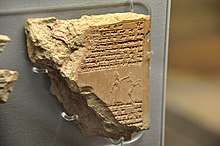Ashur-nadin-shumi
Ashur-nadin-shumi (Neo-Assyrian cuneiform: ![]()
| Ashur-nadin-shumi | |
|---|---|
| King of Babylon | |
| King of Babylon | |
| Reign | 700–694 BC |
| Predecessor | Bel-ibni |
| Successor | Nergal-ushezib |
| Died | 694 BC Elam |
| Akkadian | Aššur-nādin-šumi |
| Dynasty | Sargonid dynasty |
| Father | Sennacherib |
| Religion | Ancient Mesopotamian religion |
Biography

Babylonia had been conquered by the Neo-Assyrian Empire by King Tiglath-Pileser III (r. 745–727 BC) less than thirty years before Ashur-nadin-shumi became its king.[4] During these thirty years, Babylonia had repeatedly attempted to once more become an independent kingdom. Babylonian revolts became an especially frequent nuisance during the reign of Sennacherib, who had to defeat numerous southern revolts throughout his reign. Even Sennacherib's own appointed vassal king of the city, Bel-ibni, had revolted in an attempt to make the south independent.[5]
After defeating Bel-ibni's revolt in 700 BC, Sennacherib named his own son, Ashur-nadin-shumi, as the new King of Babylon. Ashur-nadin-shumi was also titled as māru rēštû, a title that could be interpreted either as the "pre-eminent son" or the "firstborn son". His appointment as King of Babylon and the new title suggests that Ashur-nadin-shumi was being groomed to also follow Sennacherib as the King of Assyria upon his death. Ashur-nadin-shumi being titled as the māru rēštû likely means that he was Sennacherib's crown prince; if it means "pre-eminent" such a title would be befitting only for the crown prince and if it means "firstborn", it also suggests that Ashur-nadin-shumi was the heir as the Assyrians in most cases followed the principle of primogeniture (the oldest son inherits).[2] More evidence in favor of Ashur-nadin-shumi being the crown prince is Sennacherib's construction of a palace for him at the city of Assur,[6] something Sennacherib would also do for the later crown prince Esarhaddon.[7]
As an Assyrian King of Babylon, Ashur-nadin-shumi's position was politically important and highly delicate and would have granted valuable experience to him as the intended heir to the entire Neo-Assyrian Empire. However, Ashur-nadin-shumi's tenure as Babylonian king would not last long and he was unable to handle the volatile political situation in the south.[7] In 694 BC, Sennacherib campaigned against Elam (modern day southern Iran) to chase after Chaldean rebels which had fled there. In response to this incursion into their territory, the Elamites invaded the southern parts of the Neo-Assyrian Empire and in 694 BC, probably encouraged by the Babylonians themselves, successfully captured Ashur-nadin-shumi at the city of Sippar. The prince was taken back to Elam and probably executed.[8]
References
- Bertin 1891, p. 49.
- Porter 1993, p. 14.
- Tallqvist 1914, p. 42.
- Porter 1993, p. 41.
- Glassner 2004, p. 197.
- Porter 1993, p. 15.
- Porter 1993, p. 16.
- Bertman 2005, p. 79.
Cited bibliography
- Bertin, G. (1891). "Babylonian Chronology and History". Transactions of the Royal Historical Society. 5: 1–52.
- Bertman, Stephen (2005). Handbook to Life in Ancient Mesopotamia. OUP USA. ISBN 978-0195183641.
- Glassner, Jean-Jacques (2004). Mesopotamian Chronicles. Society of Biblical Literature. ISBN 978-1589830905.
- Porter, Barbara N. (1993). Images, Power, and Politics: Figurative Aspects of Esarhaddon's Babylonian Policy. American Philosophical Society. ISBN 9780871692085.
- Tallqvist, Knut Leonard (1914). Assyrian Personal Names (PDF). Leipzig: August Pries.
Ashur-nadin-shumi Died: 694 BC | ||
| Preceded by Bel-ibni |
King of Babylon 700 – 694 BC |
Succeeded by Nergal-ushezib |